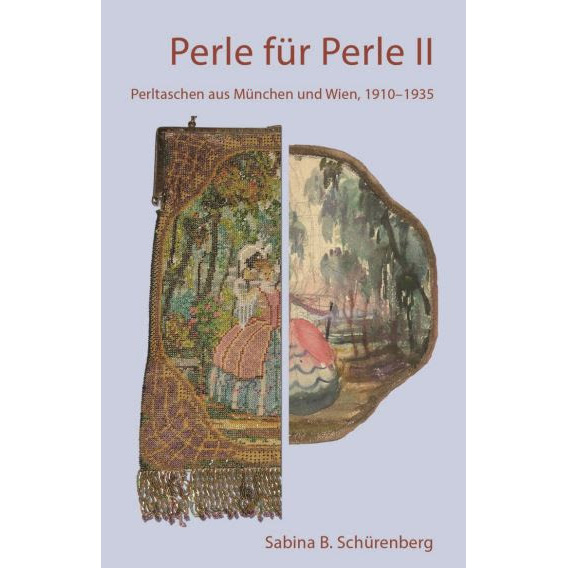Perle für Perle II
Perltaschen aus Munchen und Wien, 1910 – 1935
Purse collectors and historians have been waiting with great anticipation for Sabina Schurenberg’s book, Perle fur Perle II. It is remarkable. This is her third book on the subject of beaded purses. Previous books (titled Glasperlarbeiten Taschen und Beutel and Perle fur Perle) were groundbreaking treatments about the German/Swabian purse industry from the 19th century into the early decades of the 20th century. Now Sabina has written an in-depth examination of beaded purse designers and manufacturers from both Munich, Germany and Vienna, Austria in her latest book, Perle fur Perle II. This newest book is no less groundbreaking than her previous two books.
There are hundreds of pictures of purses from private collectors, advertisements from the period, and photos of the women and men who are the focus of Sabina’s study. Contributors will recognize their own purses and avidly look from page to page to see purses owned by other collectors. It is literally a feast for the eyes.
Because of inflationary pressures in Europe post-WWI, most bags were exported to the American market. Sabina notes that almost all the bags illustrated in the book came from collectors in America. Included at the front of the book is a list of the collectors who contributed. She kindly states that her first two books would not have been published without the cooperation of these collectors. For the first time, it was possible to see and also document the many motifs of the German/Swabian and Austrian knitted beaded bag industry. The realization of Sabina’s many years of work, culminating in these two books, enriched our understanding of beaded bags in both Europe and America.
Many years of research and work went into this second volume of the series, Perle fur Perle II, in which she explores German beaded purse companies owned by Emma Maull, Sophie Maull, and Marie Zwengauer, and the Jewish Viennese purse manufacturers Julius Frankl, Ada Grunfeld, and Paula Pollaczek. Artists Franz Xaver Unterseher, Bertha Senestrey, Kate Louise Rosenstock, and Pal Laszlo were influential designers in the industry, producing both traditional and non-representational designs in the Art Deco design aesthetic. Sabina discusses their very crucial contributions to the creative process. She was also able to speak to women who bead-knitted the purses. They talked about their lives and what it meant for them to be able to work in something other than manual labor. It is noteworthy that they were not compensated adequately for their work and, at the time, there was no thought of organizing for better pay, hours, or conditions.
Biographies of the owners and the artists/designers are included, which adds context to their lives in relation to the purses they made. She documents their personal struggles in a very unstable economic and world situation, especially in respect to Julius Frankl and Ada Grunfeld, who were Jewish and living in Vienna. Paula Pollaczek converted from the Jewish faith to the Protestant faith early in the 20th century. All three have compelling personal stories, which Sabina treats with great respect. It is important to understand their lives in the times in which they lived, as they made these beautiful pieces of art, so loved by women then and now.
Beaded purses from the 19th century and the first three decades of the 20th century are loved and valued by purse collectors. Their beautiful jewel-like colors and designs evoke a time past when purses were more than just a handbag. They had artistic merit and conferred status on the owner. As Sabina notes and shows in her book, there were three levels of quality. Bead knitted purses from Germany and Austria were of the highest quality and highly desirable then and now. The finest examples sold for hundreds of dollars. Photographs show purses with traditional floral designs, petit point inserts surrounded by beadwork, Art Deco designs, Venetian scenes, geometric/rug designs, and landscapes and figures inspired by 18th century prints and 19th century needlework.
Although there is a considerable amount of text written in English, what was written in German is easy to read using Google and a cell phone. We have Lori Blaser of the APCS to thank for this helpful information.
1. Go to Google.
2. In the search box type “translate”, specify German to English, and then tap the camera icon.
3. Scroll your phone over each paragraph and read.
I was able to read the entire book and the picture captions in three days. There is so much wonderful information in this book, I hope you will use this suggestion to translate it.
Perle fur Perle II is 671 pages and 1004 photos. The production quality of the book is excellent. It was wrapped for shipping like the work of art it is, arriving in perfect condition from Germany. Transit time was fast.
Perle fur Perle II can be ordered from the Antique Purse Collectors Society if you are a member (https://antiquepursecollectorssociety.com/). You can also order the book directly from Shaker Media in Germany (https://www.shaker-media.eu/de/).
Reviewed by Paula Higgins
Co-Author A Passion for Purses (Schiffer Publishing)
Vice President of Antique Purse Collectors Society
